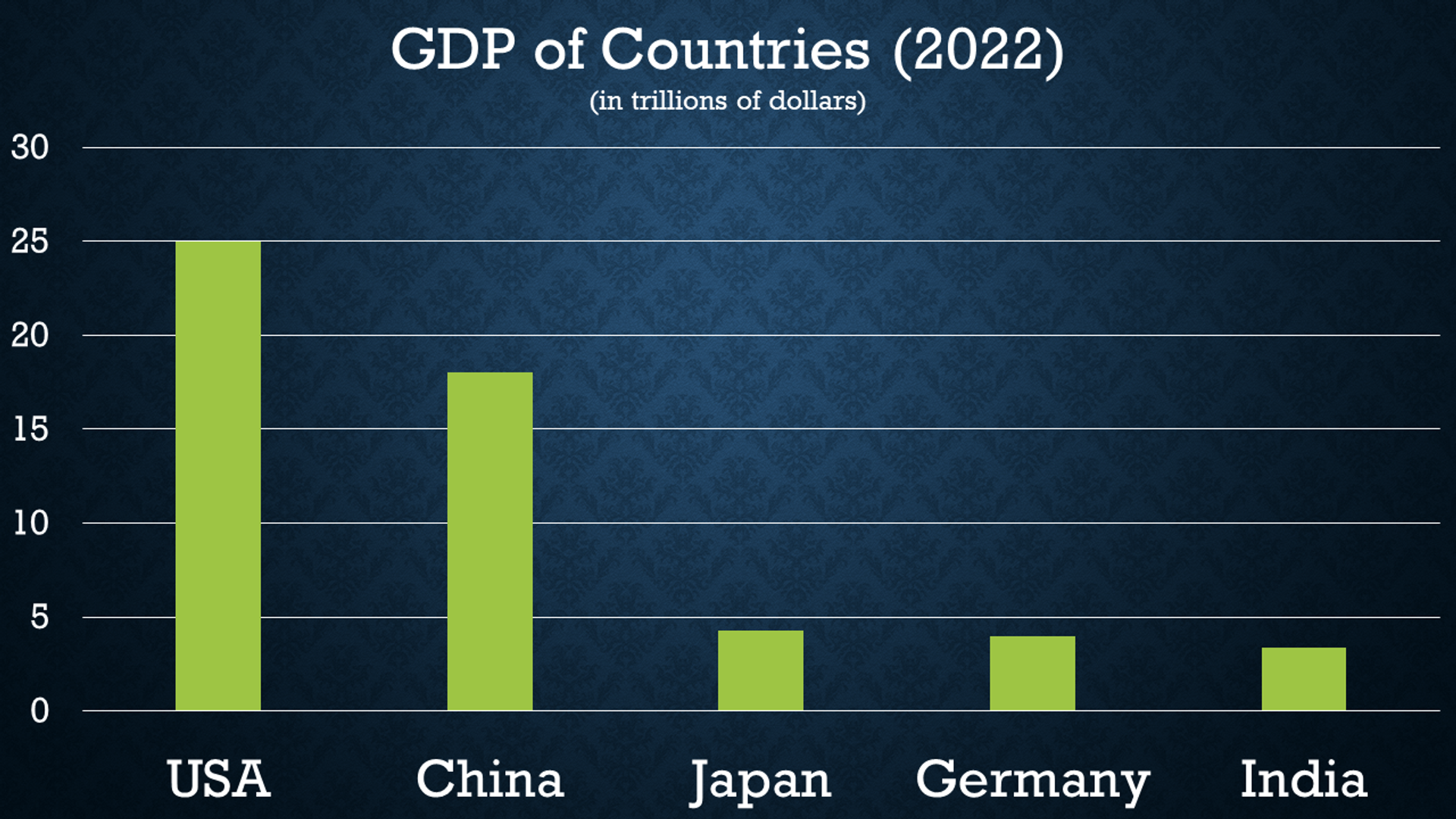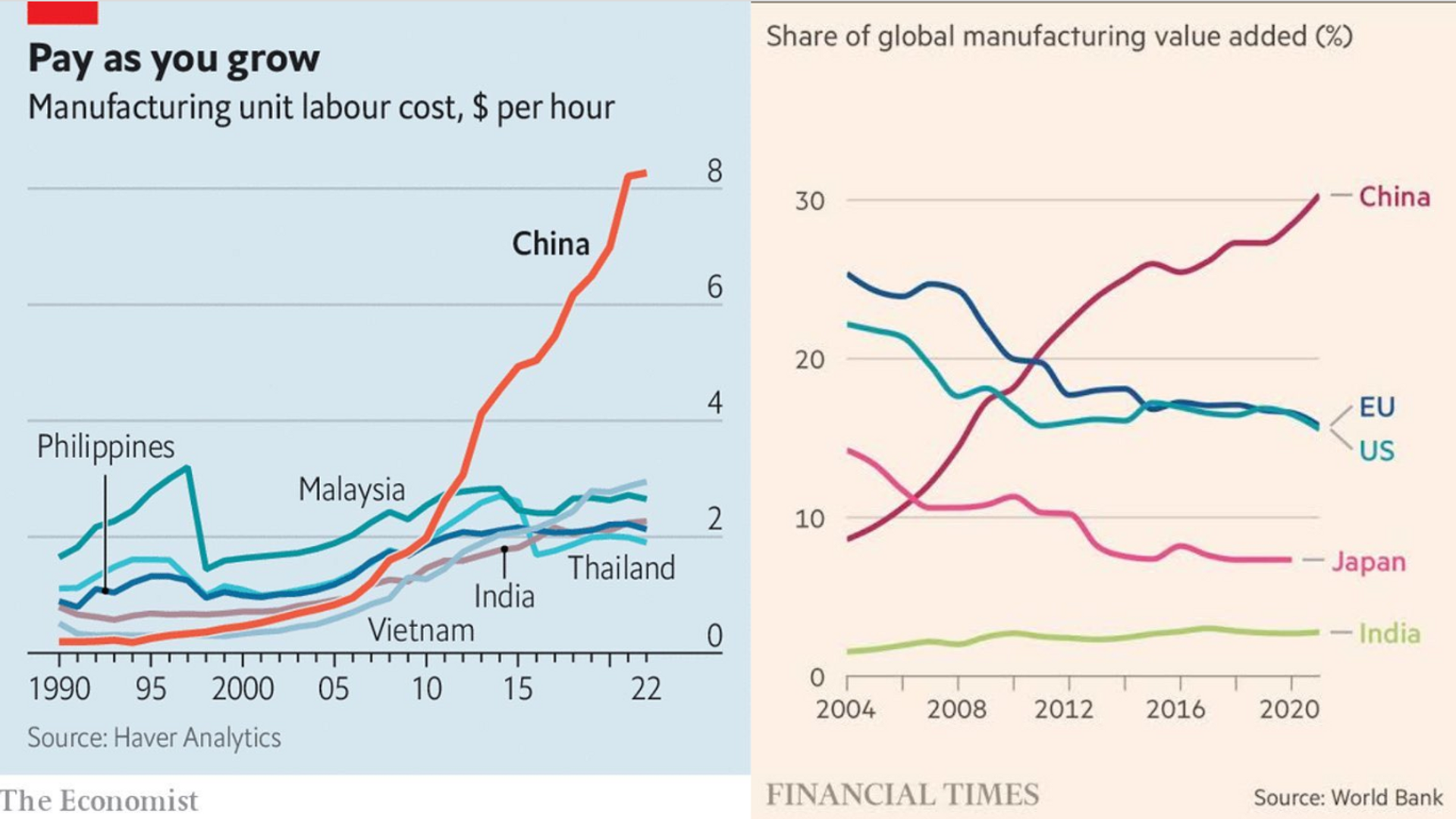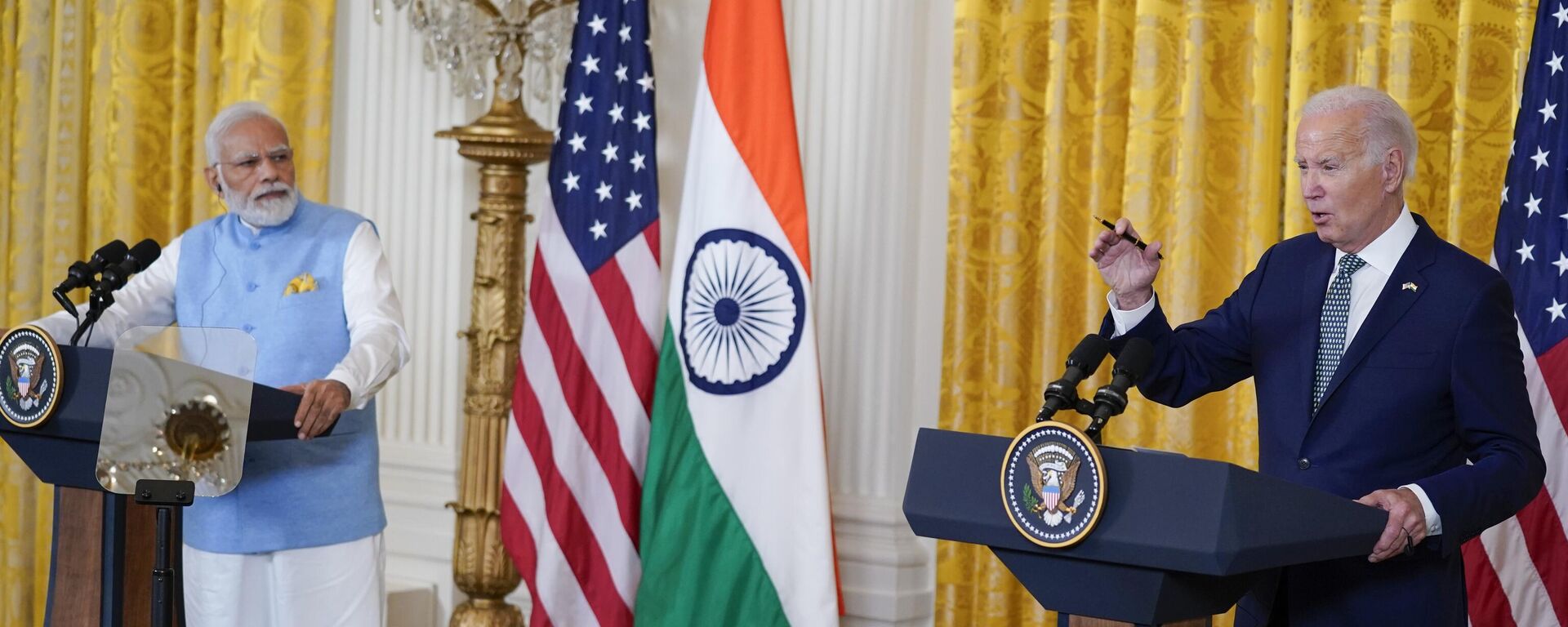https://sputniknews.in/20240417/indias-future-beyond-a-deep-well-of-cheap-labor-7146221.html
India’s Future: Beyond a Deep Well of Cheap Labor
India’s Future: Beyond a Deep Well of Cheap Labor
Sputnik India
By scrutinizing America's geopolitical strategies and emphasizing the importance of India's independent decision-making, S.L. Kanthan, a geopolitical analyst, underscores the need for strategic autonomy and indigenous solutions to drive India's progress.
2024-04-17T12:28+0530
2024-04-17T12:28+0530
2024-04-17T12:28+0530
sputnik opinion
george soros
vladimir putin
omar abdullah
us
india
china
nato
cia
microsoft
https://cdn1.img.sputniknews.in/img/07e7/07/15/3122725_0:68:3306:1928_1920x0_80_0_0_3daaff1365783e4ba1553924d22a4636.jpg
Conforming to this maxim, the US has been strategically embracing India for the last two decades, with a key objective of positioning India as a counterbalance to China and hopefully against Russia as well.While the US establishment is careful in always using diplomatic (and deceitful) language, the mask slipped off for a moment in a recent Bloomberg article, which described India as a “deep well of cheap labor.” This condescending, misguided and colonialist attitude is just the tip of the iceberg, and Indians must understand the big picture of this complex relationship with the global hegemon.The first truth is that the US attitude is not pro-India but rather anti-China. Right now, America has only one peer competitor: China. Look at the GDP of China, Japan, Germany and India – the four largest economies after the US:In other salient metrics such as trade, manufacturing, middle class population, consumer spending, technology – especially in next-gen tech like AI, 5G/6G and EV – patents, scientific publications, military spending, and diplomatic influence, China is the world’s #1 or #2.Initially, they were coy about this Machiavellian objective, but now US politicians, media and think tanks openly talk about this imperative.To stop China’s development, the US is engaging in a hybrid war, attacking China on multiple fronts. These include trade war, tech war, propaganda war, diplomatic war, economic war, color revolutions, and even possibly hot war in the near future. To that end, they are preparing Japan and some other Chinese neighbors for a kinetic war with China; and are trying to drive a wedge between Europe and China.Of course, India is one of the biggest pieces in the American geopolitical chessboard. With the world’s largest population that is also young, India has become the fastest growing major economy. The relatively high number of English-speaking and college-educated people give India an edge over many other developing nations.Divide, Conquer, Keep Them DownIndians are very well aware of the divide-and-rule strategy, thanks to two hundred years of British colonialism. However, many are not aware of how America deploys the same playbook now.Modern colonialism is very sophisticated and largely invisible. And when it is overt, clever propaganda convinces people that what they see is not colonialism! For example, the US military literally occupies countries like Japan, South Korea and Germany. If North and South Korea united or figured out a way to coexist, there would be no valid excuse for the 30,000 US occupiers to stay in the Korean peninsula. Also, shockingly, an American has been in charge of the South Korean military since the 1950s. How much more colonialism can you get?As for Japan, the people were brainwashed to accept American occupation after WW2 as some sort of punishment. Later, when Japan became too successful in the 1980s, the US destroyed the Japanese economy with the Plaza Accord. Japan was forced to strengthen its currency to such preposterous levels that Japanese exports were decimated; and Japan was forced to move its manufacturing to the US. More consequentially, the US stole Japan’s semiconductor technology and gave it to Intel, which was on the verge of bankruptcy. The Japanese even had developed a powerful operating system, which was killed so that Microsoft could become the global champion. Thanks to such a wonderful “ally” like the US, Japan’s GDP has been stagnant (in dollar terms) for the last thirty years. And now, the US is pushing Japan to change their anti-war Constitution in order for the Japanese to fight China and commit seppuku (suicide).In Europe, Germany - the industrial powerhouse with great potential – has been kept down for a century by the Anglo-American empire. After WW2, Cold War was artificially created to keep Germans and Europeans under the American boots. The fear of the USSR was the perfect excuse for NATO’s existence. After the Soviet Union collapsed, the US could have easily dismantled NATO or even included Russia in NATO. However, conflict is the raison d'être for the American Empire. This is why the US worked meticulously for the last two decades – starting with Soros-funded color revolution in 2004 - to turn Ukraine into an existential threat for Russia.Now, one can understand why the US fuels anti-China sentiments in India. If the US were a true friend, it would have helped mediate between the two neighbors. But the US has everything to gain from India-China conflicts. For one, when India banned Huawei from participating in the 5G network, the entire Indian market went to the US and its allies. This is crucial for the US, since this allows extensive spying. Second, the bans on Chinese TikTok, WeChat, AliPay Express etc. have allowed American corporations like Google, Amazon and Walmart to monopolize vital sectors like FinTech and e-commerce in India. Third, with Chinese investors gone, American oligarchs are not only taking over Indian tech startups without competition.Given all these, of course, the US would like to see fast growth in India. An empire does not mind its colonies being prosperous, as long as the profits flow back to the empire. What the empire does not want to see is a colony that eventually seeks independence and sovereignty. For example, the British wanted the American colonies to only produce cotton, but not have cotton mills. Colonial people should engage in cheap labor and buy expensive goods from the master.How does the same doctrine work in the 21st century?Now, you can see how modern colonialism works. India must stay extremely shrewd and cautious to avoid becoming another disposable pawn for the US empire.Beware the American PropagandaThe first “Red Pill” for Indians is to not get enamored by American narratives of freedom, democracy, free trade, prosperity, rules-based order and so on. Every one of those terms has fine-prints, which always benefit the US.Democracy is good only when you have a pro-US candidate versus pro-US candidate running in the elections – like how it works in Taiwan, Japan, Europe etc. However, the moment a country chooses an independent, patriotic leader who wants to do what’s best for his country, he becomes Public Enemy #1 in America – like how the West loved Yeltsin, but hate Putin.Dictators are wonderful and preferred as long as they are puppets of the US.The freedom in the US is also fake, as there is a multibillion-dollar censorship industry that is a collaboration of the US government and the media. Various social media companies like Facebook, Twitter, LinkedIn etc. are crawling with ex-deep state employees from the CIA, FBI, DNI, NSA and other alphabet soup agencies. Many of these companies give backdoor access to the US government, which can censor people in multiple ways – from outright bans to more nuanced censorship like shadow bans, throttling, demonetizing and so on.As for the legacy media, the CIA’s Operation Mockingbird – revealed during a Senate testimony in the 1970s – is still alive. Nearly 100% of the mainstream narrative aligns with the lies of the military-spy complex. Thus, you are almost guaranteed to not find a single mainstream article that talks about the US blowing up the Nordstream pipelines. Similarly, Google Search and Wikipedia, which have enormous power in shaping public opinions, work closely with the US government.As for the rules-based order, have you ever seen a document that describes these revered rules that the West apparently follows? Of course, not. There is only one rule: The US is always right and is exempt from all international laws and rules.How India Can Overcome American AmbushGiven all these disheartening facts, what should be India’s strategy? The answer is composed of two words: Prosperity and Sovereignty.How to do this would entail another article, but the broad outline of any developing nation involves urbanization, infrastructure, education and training, jobs with good wages, FDI, and exports. Here, India can forge a win-win partnership with China, which is seeking to outsource some parts of manufacturing, since China’s workforce is shrinking and factory wages are becoming too high in some sectors.Note that Bloomberg and most economic experts in the US do not understand manufacturing, which is not purely determined by cheap labor. Look at the charts below from The Economist and Financial Times:The first one shows how wages in China have grown exponentially over the last two decades – and much higher than other emerging Asian countries. However, paradoxically, China’s share of global manufacturing has also grown during the same period. Last year, China’s trade surplus in goods was nearly $900 billion – a staggering amount. The lesson here is that India can afford to pay high wages and still succeed in manufacturing.Sadly, this means that Indians who studied at Harvard and worked at the World Bank or the Atlantic Council are not going to propose the right solutions for India.ConclusionThe next decade will be consequential in architecting a new paradigm of geopolitics – a landscape of multilateralism, multipolarity, dedollarization and development. The near future will also be extremely dangerous, as seen in the conflicts in the Middle East and Ukraine. Not to mention, the US is planning on a war against China, while roping in as many “Ukraines of Asia” as possible. Amidst this chaos, India needs to think and act strategically.Taking a page out of Kissinger’s principles, India should also avoid viewing the world in simplistic terms. In other words, the US is not a permanent friend and China is not a permanent enemy. In a recent interview with Newsweek, Indian Prime Minister Modi said that the abnormal aspects of the India-China relations need to be fixed. That’s encouraging.The goal for the next two decades should be for India to become an industrial powerhouse – not just a “deep well of cheap labor,” but a land of innovation, sophisticated software, and skilled manufacturing that produces high-quality goods and services for domestic consumption and exports.S.L. Kanthan
https://sputniknews.in/20240327/india-must-reject-american-tyranny-6956437.html
us
india
china
Sputnik India
feedback.hindi@sputniknews.com
+74956456601
MIA „Rossiya Segodnya“
2024
News
en_IN
Sputnik India
feedback.hindi@sputniknews.com
+74956456601
MIA „Rossiya Segodnya“
Sputnik India
feedback.hindi@sputniknews.com
+74956456601
MIA „Rossiya Segodnya“
us establishment, india, cheap labor, colonialist attitude, global hegemon, peer competitor, gdp, trade, manufacturing, middle class, technology, ai, 5g, 6g, ev, patents, military spending, strategic cooperation, china, containment, hybrid war, trade war, tech war, propaganda war, diplomatic war, economic war, color revolutions, kinetic war, japan, europe, divide and rule, colonialism, democracy, dictatorship, censorship, operation mockingbird, rules-based order, prosperity, sovereignty, urbanization, infrastructure, education, training, jobs, fdi, exports, manufacturing, wages, global hegemony, sovereignty
us establishment, india, cheap labor, colonialist attitude, global hegemon, peer competitor, gdp, trade, manufacturing, middle class, technology, ai, 5g, 6g, ev, patents, military spending, strategic cooperation, china, containment, hybrid war, trade war, tech war, propaganda war, diplomatic war, economic war, color revolutions, kinetic war, japan, europe, divide and rule, colonialism, democracy, dictatorship, censorship, operation mockingbird, rules-based order, prosperity, sovereignty, urbanization, infrastructure, education, training, jobs, fdi, exports, manufacturing, wages, global hegemony, sovereignty
“America has no permanent friends or enemies, only interests,” said Henry Kissinger, a man who was simultaneously a brilliant geopolitical mind, a key architect of US foreign policy for many decades, as well as one of the most notorious war criminals.
Conforming to this maxim, the US has been strategically embracing India for the last two decades, with a key objective of positioning India as a counterbalance to
China and hopefully against
Russia as well.
While the US establishment is careful in always using diplomatic (and deceitful) language, the mask slipped off for a moment in a recent Bloomberg article, which described India as a “deep well of cheap labor.” This condescending, misguided and colonialist attitude is just the tip of the iceberg, and Indians must understand the big picture of this complex relationship with the global hegemon.
The first truth is that the US attitude is
not pro-India but rather anti-China. Right now, America has only one peer competitor: China. Look at the GDP of China,
Japan,
Germany and India – the four largest economies after the US:
In other salient metrics such as trade, manufacturing, middle class population, consumer spending, technology – especially in next-gen tech like AI, 5G/6G and EV – patents, scientific publications, military spending, and diplomatic influence, China is the world’s #1 or #2.
Thus, the American establishment has one goal: to contain China.
Initially, they were coy about this Machiavellian objective, but now US politicians, media and think tanks openly talk about this imperative.
To stop China’s development, the US is
engaging in a hybrid war, attacking China on multiple fronts. These include trade war, tech war, propaganda war, diplomatic war, economic war, color revolutions, and even possibly hot war in the near future. To that end, they are preparing Japan and some other Chinese neighbors for a kinetic war with China; and are trying to drive a wedge between
Europe and China.
Of course, India is one of the biggest pieces in the American geopolitical chessboard. With the world’s largest population that is also young, India has become the fastest growing major economy. The relatively high number of English-speaking and college-educated people give India an edge over many other developing nations.
The nightmare for America will be a situation when India and China have peaceful and mutually beneficial relations. Imagine the potential of nearly three billion people collaborating in harmony. That would result in a dynamic and prosperous Asia that will leave the US in the dust. Add Russia and BRICS+ to the mix, the United States becomes quite irrelevant in the global arena.
Divide, Conquer, Keep Them Down
Indians are very well aware of the divide-and-rule strategy, thanks to two hundred years of
British colonialism. However, many are not aware of
how America deploys the same playbook now.
Modern colonialism is very sophisticated and largely invisible. And when it is overt, clever propaganda convinces people that what they see is not colonialism! For example, the US military literally occupies countries like Japan,
South Korea and Germany.
However, those countries are not rebelling against the US empire because the people are convinced that the US is “protecting” them. From what? From US-created crises.
If North and South Korea united or figured out a way to coexist, there would be no valid excuse for the 30,000 US occupiers to stay in the Korean peninsula. Also, shockingly, an American has been in charge of the South Korean military since the 1950s. How much more colonialism can you get?
As for
Japan, the people were brainwashed to accept American occupation after WW2 as some sort of punishment. Later, when Japan became too successful in the 1980s, the US destroyed the Japanese economy with the Plaza Accord. Japan was forced to strengthen its currency to such preposterous levels that Japanese exports were decimated; and Japan was forced to move its manufacturing to the US. More consequentially, the
US stole Japan’s semiconductor technology and gave it to Intel, which was on the verge of bankruptcy. The Japanese even had developed a powerful operating system, which was killed so that
Microsoft could become the global champion.
Thanks to such a wonderful “ally” like the US, Japan’s GDP has been stagnant (in dollar terms) for the last thirty years. And now, the US is pushing Japan to change their anti-war Constitution in order for the Japanese to fight China and commit seppuku (suicide).
In Europe,
Germany - the industrial powerhouse with great potential – has been kept down for a century by the Anglo-American empire. After WW2, Cold War was artificially created to keep Germans and Europeans under the American boots. The fear of the USSR was the perfect excuse for
NATO’s existence. After the Soviet Union collapsed, the US could have easily dismantled NATO or even included Russia in NATO. However, conflict is the raison d'être for the American Empire. This is why the US worked meticulously for the last two decades – starting with
Soros-funded color revolution in 2004 - to turn
Ukraine into an existential threat for Russia.
Now, one can understand why the US fuels anti-China sentiments in India. If the US were a true friend, it would have helped mediate between the two neighbors. But the US has everything to gain from India-China conflicts.
For one, when India banned Huawei from participating in the 5G network, the entire Indian market went to the US and its allies. This is crucial for the US, since this allows
extensive spying. Second, the bans on Chinese TikTok, WeChat, AliPay Express etc. have allowed American corporations like
Google,
Amazon and Walmart to
monopolize vital sectors like FinTech and e-commerce in India. Third, with Chinese investors gone, American oligarchs are not only
taking over Indian tech startups without competition.
Given all these, of course, the US would like to see fast growth in India. An empire does not mind its colonies being prosperous, as long as the profits flow back to the empire. What the empire does not want to see is a colony that eventually seeks independence and sovereignty. For example, the British wanted the American colonies to only produce cotton, but not have cotton mills. Colonial people should engage in cheap labor and buy expensive goods from the master.
How does the same doctrine work in the 21st century?
Indians are expected to assemble Apple smartphones, but not develop their own smartphone, especially high-end phones that can compete with
iPhones.
Indians can work on tech support and other relatively low-end software development, but not create Fortune 500 firms that will compete with the likes of Oracle and Salesforce. Or, Indians can manufacture cheap generic drugs, but not innovate their own new pharmaceutical drugs.
The really smart Indians can become successful in the US and even become the CEOs of Google, Microsoft and IBM, but they
cannot come back to India and start Indian equivalents.
India’s labor should stay
cheap. This is accomplished by constantly reducing the value of Indian Rupee. (Yes, Wall Street and London have powerful financial weapons to manipulate currencies).
India should use its excess dollar not to invest in itself but recycle the dollars back to the US by buying US debt.
India’s middle class can become large enough to boost sales of Starbucks and Ralph Loren; and some Indians can get rich-enough to buy
Tesla cars and invest in JP Morgan’s financial products. However,
India’s GDP should stay below a certain threshold.
And the Indian mainstream media should be aligned with the US so that Indians do not understand the bigger picture.
Now, you can see how modern colonialism works. India must stay extremely shrewd and cautious to avoid becoming another disposable pawn for the US empire.
Beware the American Propaganda
The first “Red Pill” for Indians is to not get enamored by American narratives of freedom, democracy, free trade, prosperity, rules-based order and so on. Every one of those terms has fine-prints, which always benefit the US.
Democracy is good only when you have a pro-US candidate versus pro-US candidate running in the elections – like how it works in
Taiwan, Japan, Europe etc. However, the moment a country chooses an independent, patriotic leader who wants to do what’s best for his country, he becomes Public Enemy #1 in America – like how the West loved Yeltsin, but hate
Putin.
Dictators are wonderful and preferred as long as they are puppets of the US.
The freedom in the US is also fake, as there is a multibillion-dollar censorship industry that is a collaboration of the US government and the media. Various social media companies like Facebook, Twitter, LinkedIn etc. are crawling with ex-deep state employees from the CIA, FBI, DNI, NSA and other alphabet soup agencies. Many of these companies give backdoor access to the US government, which can censor people in multiple ways – from outright bans to more nuanced censorship like shadow bans, throttling, demonetizing and so on.
As for the legacy media, the CIA’s Operation Mockingbird – revealed during a Senate testimony in the 1970s – is still alive. Nearly 100% of the mainstream narrative aligns with the lies of the military-spy complex. Thus, you are almost guaranteed to not find a single mainstream article that talks about the US blowing up the Nordstream pipelines. Similarly, Google Search and Wikipedia, which have enormous power in shaping public opinions, work closely with the US government.
As for the rules-based order, have you ever seen a document that describes these revered rules that the West apparently follows? Of course, not. There is only one rule: The US is always right and is exempt from all international laws and rules.
How India Can Overcome American Ambush
Given all these disheartening facts, what should be India’s strategy? The answer is composed of two words: Prosperity and Sovereignty.
Without prosperity, a nation is vulnerable to internal strife and external attacks. Thus, the first priority of every country should be to eliminate absolute poverty and build a solid middle class – comprising at least 60% of the population.
How to do this would entail another article, but the broad outline of any developing nation involves urbanization, infrastructure, education and training, jobs with good wages, FDI, and exports. Here, India can forge a win-win partnership with China, which is seeking to outsource some parts of manufacturing, since China’s workforce is shrinking and factory wages are becoming too high in some sectors.
Note that Bloomberg and most economic experts in the US do not understand manufacturing, which is not purely determined by cheap labor. Look at the charts below from The Economist and Financial Times:
The first one shows how wages in China have grown exponentially over the last two decades – and much higher than other emerging Asian countries. However, paradoxically, China’s share of global manufacturing has also grown during the same period. Last year, China’s trade surplus in goods was nearly $900 billion – a staggering amount. The lesson here is that India can afford to pay high wages and still succeed in manufacturing.
The next is sovereignty, which means India does what is good and right for India, without interference or diktats from global hegemons or institutions. Sovereignty also means the ability to think for ourselves, without parroting strategies formulated by foreign think tanks and politicians.
Sadly, this means that Indians who studied at Harvard and worked at
the World Bank or the Atlantic Council are not going to propose the right solutions for India.
The next decade will be consequential in architecting a new paradigm of geopolitics – a landscape of
multilateralism, multipolarity, dedollarization and development. The near future will also be extremely dangerous, as seen in the conflicts in the Middle East and Ukraine. Not to mention, the US is planning on a war against China, while roping in as many “Ukraines of Asia” as possible. Amidst this chaos,
India needs to think and act strategically.
Taking a page out of Kissinger’s principles, India should also avoid viewing the world in simplistic terms. In other words, the US is not a permanent friend and China is not a permanent enemy.
In a recent interview with Newsweek, Indian Prime Minister
Modi said that the abnormal aspects of the India-China relations need to be fixed. That’s encouraging.
The goal for the next two decades should be for India to become an industrial powerhouse – not just a “deep well of cheap labor,” but a land of innovation, sophisticated software, and skilled manufacturing that produces high-quality goods and services for domestic consumption and exports.




